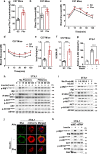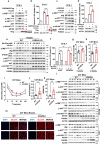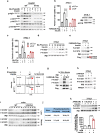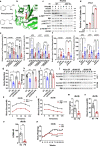Phenylalanine impairs insulin signaling and inhibits glucose uptake through modification of IRβ
- PMID: 35879296
- PMCID: PMC9314339
- DOI: 10.1038/s41467-022-32000-0
Phenylalanine impairs insulin signaling and inhibits glucose uptake through modification of IRβ
Abstract
Whether amino acids act on cellular insulin signaling remains unclear, given that increased circulating amino acid levels are associated with the onset of type 2 diabetes (T2D). Here, we report that phenylalanine modifies insulin receptor beta (IRβ) and inactivates insulin signaling and glucose uptake. Mice fed phenylalanine-rich chow or phenylalanine-producing aspartame or overexpressing human phenylalanyl-tRNA synthetase (hFARS) develop insulin resistance and T2D symptoms. Mechanistically, FARS phenylalanylate lysine 1057/1079 of IRβ (F-K1057/1079), inactivating IRβ and preventing insulin from promoting glucose uptake by cells. SIRT1 reverse F-K1057/1079 and counteract the insulin-inactivating effects of hFARS and phenylalanine. F-K1057/1079 and SIRT1 levels in white blood cells from T2D patients are positively and negatively correlated with T2D onset, respectively. Blocking F-K1057/1079 with phenylalaninol sensitizes insulin signaling and relieves T2D symptoms in hFARS-transgenic and db/db mice. These findings shed light on the activation of insulin signaling and T2D progression through inhibition of phenylalanylation.
© 2022. The Author(s).
Conflict of interest statement
The authors declare no competing interests.
Figures







Similar articles
-
Vitamin K1 inversely correlates with glycemia and insulin resistance in patients with type 2 diabetes (T2D) and positively regulates SIRT1/AMPK pathway of glucose metabolism in liver of T2D mice and hepatocytes cultured in high glucose.J Nutr Biochem. 2018 Feb;52:103-114. doi: 10.1016/j.jnutbio.2017.09.022. Epub 2017 Oct 12. J Nutr Biochem. 2018. PMID: 29175667
-
Tryptophanylation of insulin receptor by WARS attenuates insulin signaling.Cell Mol Life Sci. 2024 Jan 12;81(1):25. doi: 10.1007/s00018-023-05082-2. Cell Mol Life Sci. 2024. PMID: 38212570 Free PMC article.
-
Diabetes and branched-chain amino acids: What is the link?J Diabetes. 2018 May;10(5):350-352. doi: 10.1111/1753-0407.12645. Epub 2018 Feb 13. J Diabetes. 2018. PMID: 29369529
-
Understanding Genetic Heterogeneity in Type 2 Diabetes by Delineating Physiological Phenotypes: SIRT1 and its Gene Network in Impaired Insulin Secretion.Rev Diabet Stud. 2016 Spring;13(1):17-34. doi: 10.1900/RDS.2016.13.17. Epub 2016 May 10. Rev Diabet Stud. 2016. PMID: 27563694 Free PMC article. Review.
-
Aspartame: Should Individuals with Type II Diabetes be Taking it?Curr Diabetes Rev. 2018;14(4):350-362. doi: 10.2174/1573399813666170601093336. Curr Diabetes Rev. 2018. PMID: 28571543 Review.
Cited by
-
The Metabolic Switch of Physical Activity in Non-Obese Insulin Resistant Individuals.Int J Mol Sci. 2023 Apr 25;24(9):7816. doi: 10.3390/ijms24097816. Int J Mol Sci. 2023. PMID: 37175541 Free PMC article.
-
Accelerated biological aging, mediating amino acids, and risk of incident type 2 diabetes: a prospective cohort study.J Endocrinol Invest. 2025 Feb;48(2):435-443. doi: 10.1007/s40618-024-02436-w. Epub 2024 Oct 3. J Endocrinol Invest. 2025. PMID: 39361235
-
First Report of FARSA in the Regulation of Cell Cycle and Survival in Mantle Cell Lymphoma Cells via PI3K-AKT and FOXO1-RAG1 Axes.Int J Mol Sci. 2023 Jan 13;24(2):1608. doi: 10.3390/ijms24021608. Int J Mol Sci. 2023. PMID: 36675119 Free PMC article.
-
Mechanisms of metabolism-coupled protein modifications.Nat Chem Biol. 2025 Jun;21(6):819-830. doi: 10.1038/s41589-024-01805-z. Epub 2025 Jan 7. Nat Chem Biol. 2025. PMID: 39775169 Review.
-
Amino acid intake, plasma metabolites, and incident type 2 diabetes risk: a systematic approach in prospective cohort studies.Nutr J. 2025 Jul 16;24(1):112. doi: 10.1186/s12937-025-01157-x. Nutr J. 2025. PMID: 40671038 Free PMC article.
References
Publication types
MeSH terms
Substances
LinkOut - more resources
Full Text Sources
Medical
Miscellaneous

